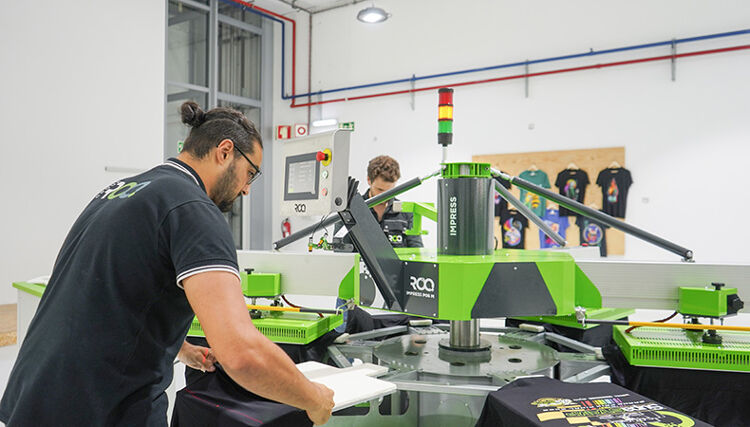The rise of DTF: ROQ and the Impress

Nelson Miranda, Marketing Specialist at ROQ, looks at the growth of direct to film (DTF) in the garment printing sector and beyond.
What are the critical advantages of DTF directly applied decoration?
The main advantages of DTF are:
- No need to open screens compared with screen printing.
- Registration problems are eliminated.
- No need for dryers to dry the inks.
- No need for great know-how for the application.
- Better results in the colours of the print.
With the ROQ Impress, you can achieve high-quality industrial production. It is flexible and versatile. In addition, it has a production rate of up to 500 pieces per hour, which optimises time and speeds up the application process.
What is the Impress’s breadth of applications? What can it and can’t work on?
The ROQ Impress is built to press multiple types of heat transfers, including DTF, screen print, digital/screen hybrid, vinyl and specialty transfers, making printers’ lives easier for those specialty fabrics and hard-to-print items. The machine can also handle add-on applications such as twill, rhinestones, foil, and more.
What are the limitations of direct to garment (DTG) in comparison?
ROQ’s DTG machines are among the most advanced on the market: they have the best wash fastness due to DuPont’s advanced ink chemistry and the also best price vs cost relation in our powerhouse, the ROQ NOW. But they (and all DTG machines) have limitations: when it comes to the substrate used, the substrate has to be clothing or fabrics.

What flexibility and customisation options are available for designers?
The ROQ Impress is ideal not only for fashion garments but also for sportswear and all other possible heat transfer applications, all of which allow huge flexibility and customisation options for designers.
Where does DTF sit as a textile decoration method?
In recent years we have seen an exponential growth in DTF as a textile decoration method. Its growth is limited to a niche, but the great flexibility of applications means that this niche will keep on growing beyond fashion garments and sportswear, predominantly in the gifts, advertising and tourism markets.
Which other sectors can we see DTF growing into?
It will gradually grow into small print local shops, whose target audiences are tourism, low-volume advertising and personalisation of gifts.
What are the sustainability benefits of DTF and how can these be improved further?
The sustainability benefits of DTF are that most productions are for almost immediate consumption – it doesn’t create large stocks, which are then sent to various parts of the world to be sold in retail shops, but mostly serves local markets.
How does the quality of prints produced using DTF compare with other printing techniques?
It doesn’t have the same quality or wash resistance as screen or digital prints, but it’s perfectly acceptable.

What measures are taken to ensure the durability of prints over time?
There are two very important factors that ensure the durability of prints over time.
One is the quality of the transfers, and obviously the cheapest ones, mostly produced in the Far East, are less durable and sustainable.
The other is the quality of the heat press. The added value of the Impress is that it uses advanced technology and engineering to standardise the pressure and to automate the process of applying transfers using the structure of a circular machine with pallets with rubberised tops to dissipate the heat that the heat presses apply to the substrate, activating the glue, and making it possible to elaborate on types of fabric that are difficult to print on screen or digitally.
What advice would you give to businesses or designers looking to implement DTF successfully?
It is essential to choose a machine that has laser markers for accurate placement of transfers, is fully programmable from the control panel, including recipe selection, and which incorporates a feature for standardising the pressure applied by the heat press. That will ensure quality and reliability of the heat transfer process.
The ROQ Impress does all that while allowing fast set-ups, pressure, temperature and the time of each heat-press plate adjustment. It also has an automatic feeder for perfect positioning of the transfers on the different substrates.
Become a FESPA member to continue reading
To read more and access exclusive content on the Club FESPA portal, please contact your Local Association. If you are not a current member, please enquire here. If there is no FESPA Association in your country, you can join FESPA Direct. Once you become a FESPA member, you can gain access to the Club FESPA Portal.
Recent news

Regulation guidance: Corporate Sustainability Reporting Directive
The Corporate Sustainability Reporting Directive (CSRD) is now in effect, but with further changes on the horizon, what does it mean for printers? Sustainability consultant Rachel England outlines everything you need to know and talks to Apigraf about how your business may be affected.

Web-to-print design: Canva versus Kittl
We look at popular design packages Canva and Kittl to determine how they compare regarding graphic design and print on demand.

FESPA in South Africa: the print skills to thrive
Printing SA’s Career Day inspired young Cape Town learners to explore printing and packaging careers.

The rise of Chinese printers
Chinese printing companies are on the rise, and have their eyes set on the UK and EU marketplace. Some have made an instant impact; others are running into issues with maintenance and language barriers. What does the future hold for Chinese printing firms, and how can you navigate working with them?